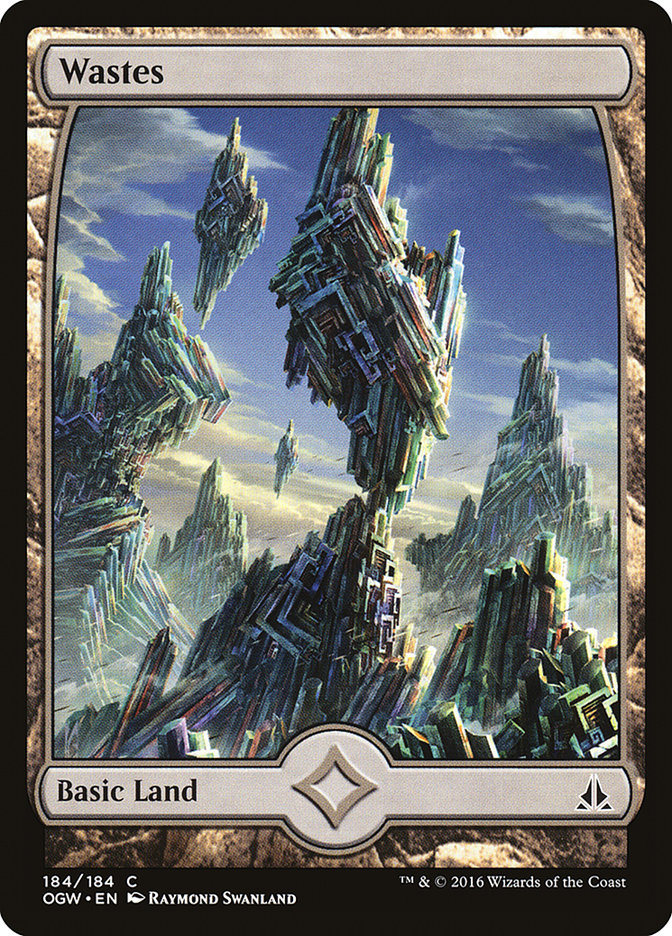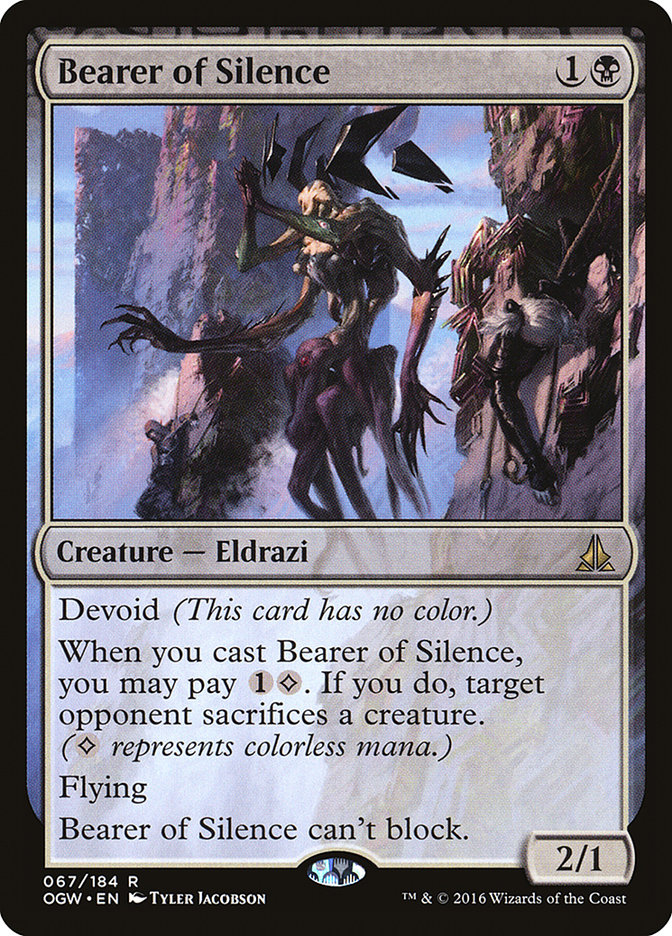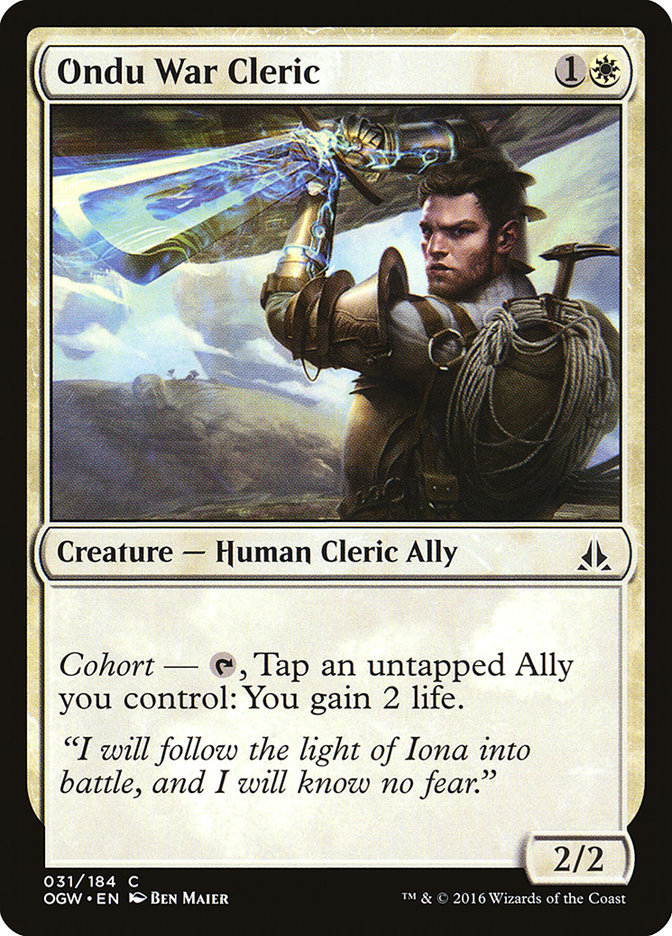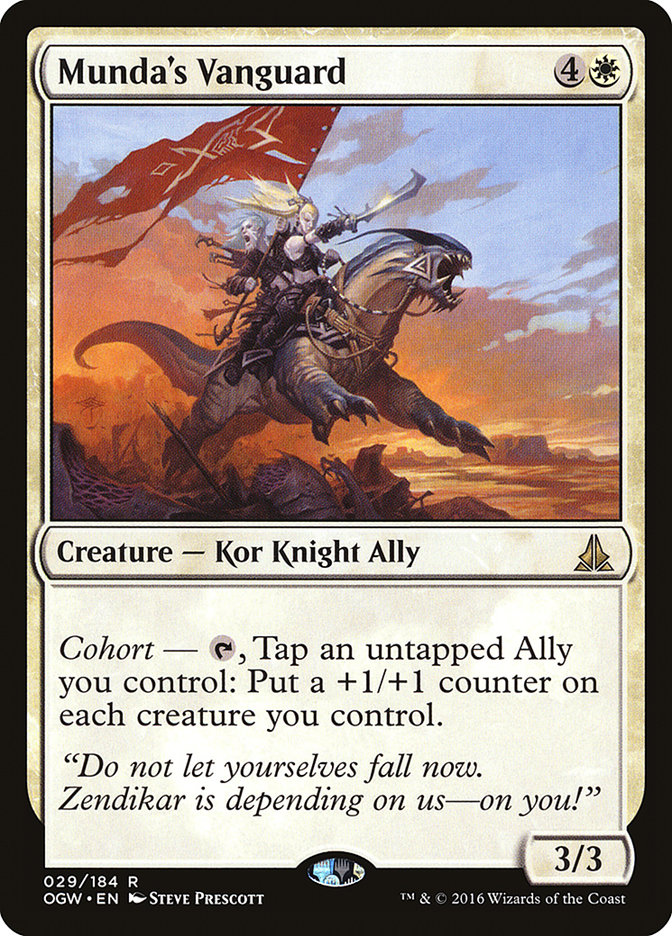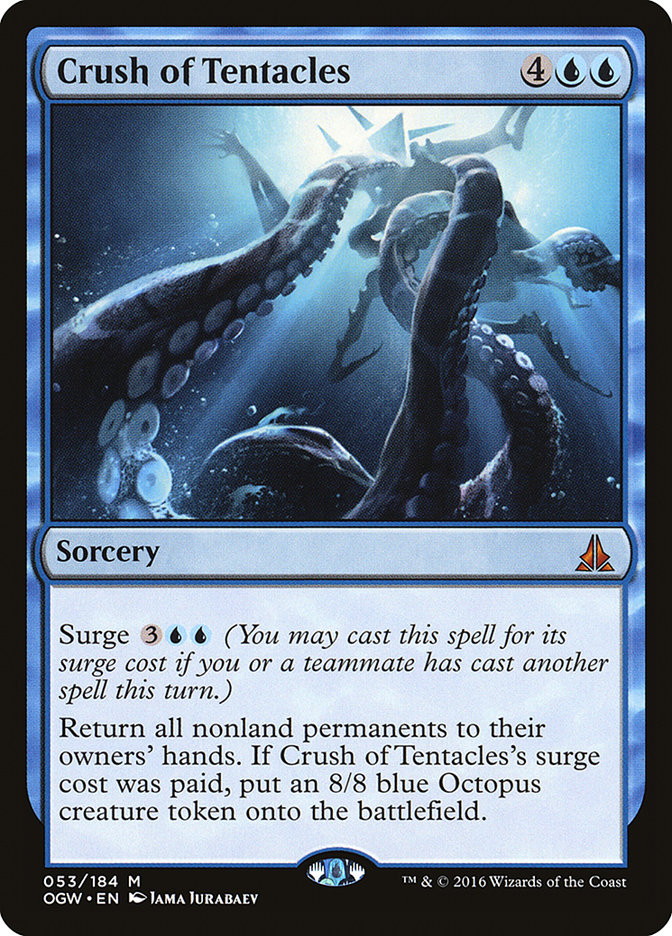Hey everyone!
Welcome back to Ask a Judge. I hope you had a fantastic prerelease for Oath of the Gatewatch! I had a great time at my local game store, Montasy Comics in Manhattan, where the house was packed with about 60 players — on a Saturday morning, even! I built a U/R deck with some splashy bombs and so-so removal spells. I started 2-0, but was vanquished by my next opponent’s Nissa, Voice of Zendikar and ultimately ended the day 2-2. Ah, well. At least that’s my favorite set of power and toughness!
Bear puns aside, Oath is shaping up to be a great set! I’m super excited to share some knowledge and answer your questions about the new set — and, this week, I have a very special guest! When thinking of who made the most sense to join me for this article, I knew I wanted someone who had a ton of knowledge about the set…so why not ask someone who judged an Oath of the Gatewatch event before the set even officially came out? This could mean only one person: Head Judge of the Oath of the Gatewatch World Premiere, Nichole Johnson!
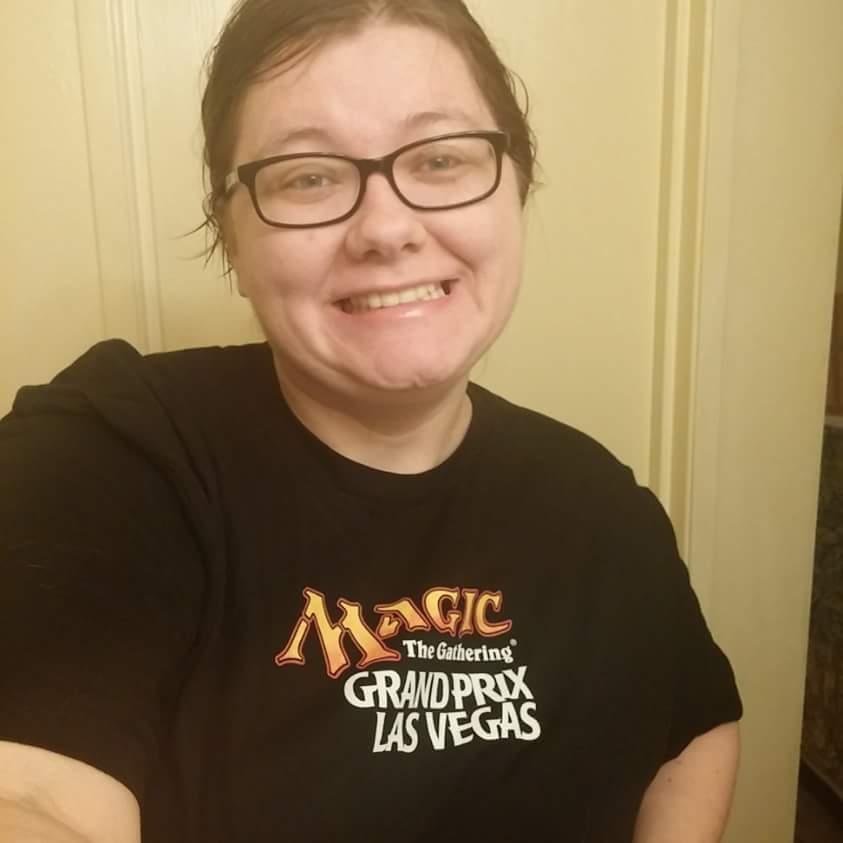
What’s the World Premiere? Two weekends ago, Wizards put on a very special event at GP Oakland. Imagine your typical Oath of the Gatewatch Two-Headed Giant event…but hold it a week before the actual prerelease, add the chance to qualify through special events, sprinkle in some celebrity teams, and you have a really awesome experience brewing. If you haven’t seen it yet, check out Wizards’ photo essay about the event!
So why was Nichole chosen to head judge this awesome event? It turns out that, in addition to being a great judge, she has a special fondness for Two-Headed Giant. She’ll talk about that later — but for now, let’s get to the new set!
Nichole and I are going to focus on breaking down the new mechanics from Oath of the Gatewatch — the colorless mana symbol, cohort, surge, and support — since that will cover a large swath of questions. If you have more specific questions, leave them in the comments or shoot me an email at [email protected] and I’ll make sure to answer them!
New Mechanic: Colorless Mana
(Bearz) This is the big one…a change that began with Oath of the Gatewatch, but will have an impact throughout Magic’s history. I’m talking about our new symbol for colorless mana:

This symbol, abbreviated {C}, means one colorless mana. As you know, Magic has five colors of mana — white, blue, black, red, and green. The colorless mana symbols you’ll see in Oath of the Gatewatch don’t change this fact. There are still only five colors of mana. As it turns out, though, the game has always had six types of mana: white, blue, black, red, green, and colorless.
What’s colorless mana? Well, it’s just mana that doesn’t have a color. Plenty of lands and other cards have generated colorless mana, all the way back to Sol Ring in Alpha. So that’s nothing new. What is new is the symbol for colorless mana. Going forward, all cards that produce colorless mana will use this new symbol. Moreover, all old cards that produced colorless mana (including Sol Ring itself) have been updated to use the new symbol, too. This is important because it allows us to clearly distinguish between colored mana production and generic mana costs.
What’s a generic mana cost?
Even if you’ve never heard that rules term, you’ve seen these symbols before: they’re the numbers that appear in gray circles on tons of cards. A symbol like {1} represents a cost that can be paid with any type of mana. For example, you can pay {W}, {U}, {B}, {R}, {G}, or {C} to cast a Sol Ring. That same Sol Ring, when tapped, will then produce {C}{C}. This used to be represented as {2}, but as I mentioned earlier, that’s been done away with, to clarify that colorless mana is very different from generic costs.
Why does that matter?
Consider the two new Eldrazi titans: Ulamog, the Ceaseless Hunger and Kozilek, the Great Distortion. You’ll notice that Ulamog costs {10} whereas Kozilek costs {8}{C}{C}. Let’s say you have 10 Mountains. You can cast Ulamog — because you can pay his cost with any ten mana. But you can’t cast Kozilek, because the {C}{C} in his cost specifically requires colorless mana. There are lots of other cards in Oath of the Gatewatch that cost {C}, so this will matter a lot for Limited and Constructed games alike!
What’s a “Wastes”?
Wastes is the name of a new basic land printed in Oath of the Gatewatch. Unlike other basic lands, Wastes has no basic land types and it doesn’t produce colored mana. Instead, it taps for {C}.
Because Wastes is basic, you can find it with Evolving Wilds or Natural Connections, and you can play as many as you want in Constructed formats (including any Commander deck).
However, because it has no types, it doesn’t impact cards that care about “all” basic land types (like Coalition Victory) or domain cards (like Allied Strategies). Nor can you choose “Wastes” when asked to choose a basic land type (like Realmwright). Finding it with Farseek is right out.
Can I play as many Wastes as I want in a Draft or Sealed event?
Sorry, but no. Wastes is special. To play one in your Sealed deck, you have to open it. Similarly, to play Wastes your Draft deck, you have to spend a pick on it — make sure you don’t take it out of the pack if you open one! This was done for a couple of reasons, including being able to make cards that cost {C} a little more powerful, since you have also figure out how to cast them.
Can I play Bearer of Silence (a black card with an ability that costs {C}) in my Drana Commander deck?
Sure! I’m not sure how Drana feels about having some Eldrazi in the same deck as her…but colorless is not a color, so the {C} symbol doesn’t change any card’s color identity.
Does Kozilek’s Channeler make two Wastes mana now?
For what it’s worth, it’s not “Wastes mana” or “void mana” or even “diamond mana.” It’s just colorless mana. It’s the same kind of mana that Kozilek’s Channeler and other cards have always produced, just with a new symbol!
That being said, yes, Kozilek’s Channeler produces {C}{C} — two colorless mana. You can use this mana to cast spells like Warping Wail, as well as pay the {C}{C} cost for Kozilek, the Great Distortion (flavor!).
I control an Animar, Soul of Elements with 10 +1/+1 counters on it. Can I cast Kozilek, the Great Distortion for free?
No. This is one of the reasons why adding a symbol for colorless mana is very helpful. Animar reduces the generic mana portion of creature costs. This means that Animar’s discount only applies to the numeric portion of a creature spell’s cost, not any colored symbols or {C} symbols. This is further reflected by the fact that Animar’s official rules text is the same now as it was when Animar was released; it didn’t change with the release of Oath of the Gatewatch.
—
All right, enough about that crazy new symbol. Let’s talk about the other mechanics in Oath of the Gatewatch! First up is Nichole with some questions about cohort.
New Mechanic: Cohort
(Nichole) Allies return! Teamwork seems to be an underlying theme in Oath of the Gatewatch. Not only are players rewarded for teaming up, but so are their creatures.
Cohort lets you tap an Ally with the cohort ability, plus any other Ally you control, to gain an effect.
To activate a cohort ability, the Ally with the ability can’t have summoning sickness. However, you may use an Ally you just played to pay the other part of the activation cost, “Tap an untapped Ally you control.” This is because only costs that specifically have the tap symbol care about summoning sickness.
I control Ondu War Cleric & Munda’s Vanguard. Can I tap them both to activate each other’s abilities and gain both effects?
Sorry, no. An Ally can’t be tapped for both the “Tap an untapped Ally you control” part of a friend’s Cohort ability and the “{T}” cost of its own activation.
Concrete example: Let’s say you only control Ondu War Cleric and Munda’s Vanguard. If you would like to activate the Cohort ability of either, you would have to choose which ability you are activating and then pay the appropriate costs. You will either gain 2 life or put a +1/+1 counter on each creature you control. You cannot choose to do both abilities, as both creatures would get tapped in the process of activating the first ability.
Can I tap my teammate’s Allies to activate my creature’s cohort ability? I’d really like to tap my teammate’s Vampire Envoy to activate my Malakir Soothsayer.
Cohort requires that you tap an Ally you control. As you do not control your teammate’s Vampire Envoy, this will not work. Keep this in mind when building decks for a team format, like Two-Headed Giant or Team Sealed!
New Mechanic: Surge
(Nichole) Best 2HG ability ever! Not only do I get to pay less mana for my stuff (made easier by having a teammate who can also cast stuff), but sometimes it gets a cool ability when I do. Tyrant of Valakut seems kind of lackluster as a 5/4 flyer that costs 5RR. But cast it after you or your teammate have cast a spell and suddenly he’s a 5/4 flying monster who also does three damage to a creature or player…for two less!
Something to remember about surge is that it is an alternative cost. So what exactly does that mean? Let’s revisit some old friends who helped us learn about alternative costs:
What happens if I target my Crush of Tentacles in my graveyard with Snapcaster Mage?
As we learned with Awaken, you can’t apply multiple alternative costs to the same spell. If you want to cast your Crush of Waves from the graveyard using Snapcaster Mage’s ability, you would have to pay its Flashback cost and would not be able to use the Surge cost. Not only will it mean you have to pay more, but you also won’t be getting that snazzy 8/8 blue Octopus token.
But if I use Jace, Telepath Unbound’s -3, I can Surge, right?
Yes! Just like with Awaken, Jace is allowing you to cast the spell and is not giving you an alternative cost. That means, since no other alternative costs are being applied, you are free to use the Surge cost.
Let’s say I cast Emeria Shepherd, play a Plains, and use Emeria Shepherd’s ability to return my Reckless Bushwhacker to the battlefield from the graveyard. Do my creatures get haste and +1/+0?
You get a Reckless Bushwhacker whose enter the battlefield effect doesn’t trigger. When you use Emeria Shepherd’s landfall ability to put Reckless Bushwacker onto the battlefield, you are not casting him — you’re simply moving him from the graveyard to the battlefield. His surge cost wasn’t paid and you’re not even casting him, so none of your creatures will gain the benefit of the Bushwhacker’s ability.
Can I become teammates with another player in Commander?
(Bearz) Nice idea, but no. You can only have a teammate in formats that specifically have teams. This mostly means Two-Headed Giant, but the Archenemy format also features a team fighting against a single terrifying opponent. (Hey, that’s kind of like the Gatewatch versus the Eldrazi…) You could also invent your own format that involves teammates.
However, you are not teammates with anyone in Commander. And in spite of the name, Team Sealed is actually treated as three independent matches. None of the people on your team (for match record purposes) are actually on your team (for gameplay purposes). Try reading that one twice.
New Mechanic: Support
(Bearz) And, last but not least, we have support. Like cohort, support encourages you to play lots of creatures and “go wide.” Support appears on both spells and abilities, and it’s phrased as the word support plus a number, such as “support 2.” On spells, this simply means “Put a +1/+1 counter on up to two target creatures.” If a spell has effects besides supporting, just follow the instructions in order.
Because of the “up to”, you can target zero, one, or two creatures. (Flexibility!) The word “target” means you have to announce what creatures are getting counters when you cast the spell with support. You can’t change your mind later. (OK, maybe not as much flexibility as you thought.)
Creatures with abilities that support work mostly the same way. The only difference to keep in mind is that creatures with abilities that support can never target themselves. A card like Relief Captain (a 3/2 with support 3) wants three other buddies to reach peak supporting efficiency.
Can I target my teammate’s creatures in Two-Headed Giant?
Absolutely! Like surge, this is another mechanic that’s pretty good in single-player, but really shines in formats like Two-Headed Giant.
What about Commander and other multiplayer formats?
Targeting any creature means just that. They don’t have to be yours, and you don’t need permission. So go nuts. I love the sweet smell of politics in the morning!
What happens if one of my targets becomes illegal?
If the spell or ability still has one or more legal targets when it resolves, you can’t affect any illegal targets, but you’ll otherwise do as much as you can. Let’s say you have two Knight Ally tokens, and cast Shoulder to Shoulder targeting both of them. In response, your opponent exiles one of your tokens. You’ll still put a counter on the remaining Knight Ally and then draw a card.
In contrast, suppose your opponent had two removal spells, and killed both your Allies. How rude. In that case, Shoulder to Shoulder has no legal targets left, so the entire spell is countered, and you won’t even draw a card. Sad times for the Gatewatch.
====
That’s all the rules questions we have today. But before we go, it’s time for some questions with Nichole! When she isn’t traveling around the Southwest United States for Magic, Nichole lives in Victorville, California, with her three adorable Chihuahuas and three wonderful kitties. She works for the County of San Bernardino as an Eligibility Worker for public assistance programs.
When did you become a judge, and why?
I became a certified judge in August 2009. Up until then, I had spent several years as the Tournament Organizer for a shop I co-owned at the time. I became a judge because I really developed a love of the game through organizing the events and I wanted to be more involved. Competitive play held no interest for me, and judging was a good way for me to be a part of that scene without having to play.
Fun fact: even though I became a judge to be able to enjoy Magic without playing on the competitive scene, the very first large competitive event I judged was a Sealed PTQ I had attended with the intent to play. The Head Judge realized the attendance was much higher than anticipated. He found out I was a judge, walked right up to me, and handed me back my entry fee and told me I was judging. I didn’t get to play any Sealed that day, but for my first competitive judging experience, I think missing out on the Sealed was worth it.
What’s your favorite card from Oath of the Gatewatch?
This question is a tough one. Oath of the Gatewatch has a multitude of cards that really speak to my inner Two-Headed Giant geek. However, one card really made me giddy when I saw it. 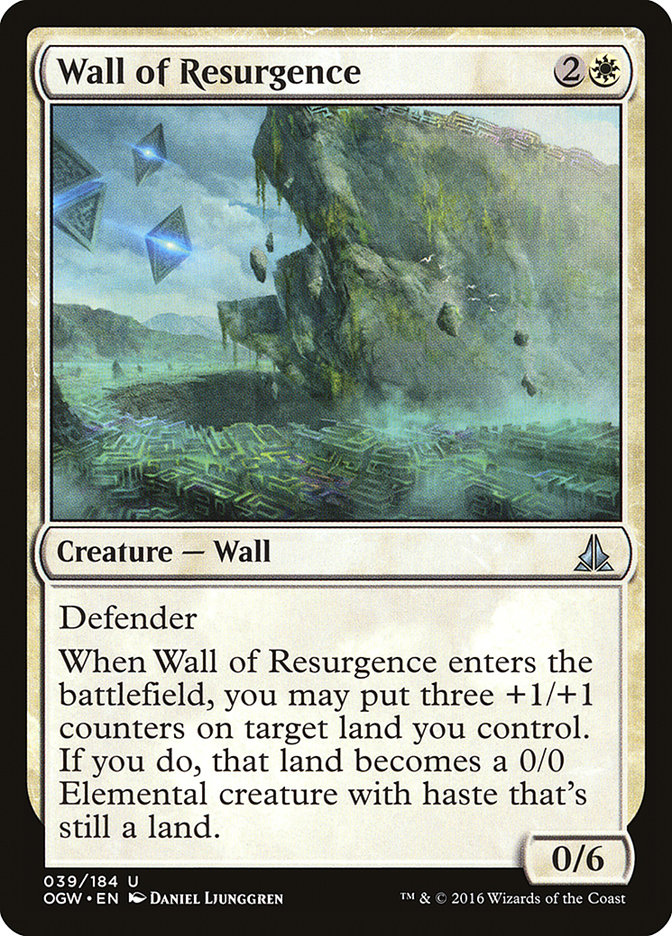
As someone who really enjoys Limited, the card I was most intrigued by was Wall of Resurgence. The amount of power you get out of this uncommon for only three mana is pretty sweet. Not only do you get a blocker that can be difficult to get through with its six toughness, but you get a 3/3 creature that can attack and block as well. I can honestly tell you this is a card I want to open multiples of in my sealed pool.
Also, Expeditions.
What’s your proudest Magic accomplishment?
Back in the era of Pro Tour side events (around 2010), I had the pleasure of working sides at PT San Diego. It was definitely daunting, as I had never been to anything larger than a PTQ at the time. It sort of felt like being thrown into a wave pool and being asked to perform water ballet. This was also the first time I met many of the high-level judges, and I will admit I was very much starstruck. I was determined to not make this the last huge-scale event I got to participate in, so the stakes were high for me. I felt very wet behind the ears and had serious confidence issues when it came to delivering correct rulings, especially when it came to unfamiliar formats.
At one point during the event I was judging a Legacy tournament and was called over to a table where both players were heated. The active player was playing Elfball and was trying to combo off. He showed his opponent his combo and said he was going to repeat it to gain a million life with his Essence Warden. His opponent had informed him that he had just decked himself, which he did not agree with. This is when I was called to the table.
There was a lot of agitation at the table, and I, in my doe eyed wonder, mustered up my strength to try and keep both players from earning Unsporting Conduct penalties. I had never played Legacy, and was only vaguely familiar with what an “Elfball” combo deck even was. I had one thing in my favor: comboing off was the ruling du jour during that time in Magic history, so I was super familiar with how that piece worked! (Yay Internet!)
After consulting a bit with my Head Judge, I was given the sage advice of “You’ve got this. Make a ruling.” So I walked back to the table with the utmost confidence that I knew what I was doing. I asked the active player to show me the combo he was planning to repeat a million times, and right smack dab in the middle was an Elvish Visionary that he bounced to his hand with his Cloudstone Curio and replayed to untap his Nettle Sentinels. He was quite sad as I ruled what the Elvish Visionary being part of his combo meant, and I could tell he was hoping I would let him try to figure out how to complete his combo a different way.
I am very proud of myself for making this tough call and sticking to it. It seemed a fairly complicated call for my inexperienced self, but my sage Head Judge had been correct, and I still hold that advice dear to my heart. I did have it. I walked away from that table feeling confident in my ability to make a ruling, even the ones that are no fun for anyone involved.
I also got to Head Judge a huge Two-Headed Giant event that weekend when both the Head Judge and his XO had emergencies and had to leave. I just kept remembering, “I got this.” I did… and I’ve been head judging Two-Headed Giant events at Grand Prix ever since.
What was judging the Oath of the Gatewatch World Premiere like?
Only the single most exciting judging experience I’ve had in my life!
It was the third time I was able to make history as a magic judge — the first two being getting to work on both Modern Masters GPs in Las Vegas. I have never had a more excited group of players in an event, and we got to learn how some of the spells worked together. I was very nervous when I found out I was going to have the honor of running the event, but the closer the event got, the more I realized that there was nothing I would rather be doing at the wind down of GP Oakland then watching players strategize the best time to play Linvala, the Preserver or try to recover from a well-timed Remorseless Punishment.
The real highlight for me was the joy of our youngest competitor when his opponents in the final round learned how bummed he had been when he hadn’t opened a mythic, so they let him have their Nissa, Voice of Zendikar. After word spread, I think he ended up with 6 mythic rares.
===
Aw, what a great story! Thanks so much for joining me this week, Nichole!
I hope you all enjoyed your Oath of the Gatewatch Prerelease and are looking forward to brewing with the new cards in Standard, Modern, or whatever format you enjoy best!
As always, I’m on the lookout for questions to answer and share in the community. If you ever find yourself tangled up by Thought-Knot Seer or any of the other new cards, leave me a comment, or drop me a line at [email protected]! Your question might even be featured in my next article.


